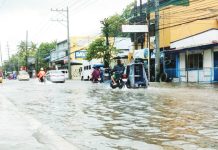
IT HAS been three weeks since President Rodrigo Duterte imposed a one-month “community quarantine,” initially in Metro Manila and eventually spreading out nationwide in collaboration with the local government units. The aim: to lick the creeping coronavirus disease (COVID-19) that sprang from Wuhan City, China in December 2019.
Duterte’s was a belated initiative; many other countries by then restricted entry and exit of people within specified zones.
Local government units have been ordered to implement their own versions of lockdown with diverse modes of implementation, which are already familiar to everybody.
Have we as a nation succeeded in at least achieving “flattening the curve” of the plague? Perhaps, all we have succeeded so far is in preventing a worse “what could have been without the lockdown.”
Looking from a bird’s eye view, as of yesterday, COVID-19 cases worldwide had ballooned to 1,098,006 cases, of which 59,141 had died.
The most powerful country, the United States, is now the epicenter of the pandemic with 277,161 cases, of which 7,392 had died.
The Philippines had 3,018 cases as of yesterday. Of that number, 136 had died and only 52 had recovered.
If the figures as gathered by the World Health Organization in its “odometer” were to be the basis, the percentage of fatalities seems negligible.
On the 3,018 cases in the Philippine, for example, while 136 had died and more than 52 had recovered, the greater majority are hanging on.
But with no known cure or vaccine to nip COVID-19 in the bud, what makes the disease even more dreadful is its exponential “infectiousness”.
Going back to the Philippine figures, the 3,018 published on Saturday was a big jump of 707 over the 2,311 cases reported two days earlier.
That keeps us wondering whether there must be a way better than the “lockdown” which could lead to collapse of the economy.
South Korea has proven there is such a way. According to Foreign Minister Kang Kyung-wha, with the exception of closing the schools, her country has not imposed lockdown. Since January 2020 when the news of its 30 COVID-19 cases broke, it has been implementing widespread testing. Those who fail the test are immediately isolated for intensive care in hospitals.
“We have tested over 350,000 cases so far,” Kang told the World Economic Forum. “Some patients are tested many times before they are released.”
In the Philippines, the scarcity of testing kits explains why everybody has to be presumed “infected”; hence, the strict enforcement of “social distancing”.
There is so far only one testing center in our region, the Western Visayas Medical Center in Iloilo City, which has the maximum capacity of testing only 40 cases per day.
“Ill-advised,” Mayor Jerry Treñas hollered over the sudden removal of Department of Health (DOH) regional director Marlyn Convocar as overseer of Western Visayas’ “Response to COVID-19.” Taking her place by “remote control” is Central Visayas’ regional director Dr. Jaime Bernadas.
Cong. Janette Garin (1st District, Iloilo), on the other hand, had earlier lashed at Convocar for declaring the entire population of Guimbal “persons under monitoring” – hence banned from moving out of their homes – because of two COVID-positive cases thereat.
Convocar consequently took back her statement but that did not stop the DOH main office from axing her as COVID overseer.
Meanwhile, the good news is that The Medical City-Iloilo has sent home a recovered COVID-19 patient.
We wonder what steps the municipality of Lambunao, Iloilo would do for the “family of all six,” home-quarantined for allegedly being COVID-asymptomatic. One them have died. (hvego31@gmail.com/PN)





